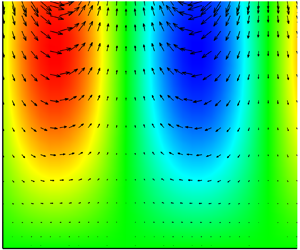Published online by Cambridge University Press: 03 March 2023

The surface wave instability (SWI) of thermocapillary migration is examined by linear stability analysis for a droplet on a unidirectional heated plane. Both a Newtonian fluid and an Oldroyd-B fluid are considered. The droplet, flattened by gravity, is susceptible to two kinds of instabilities: convective instability (CI), which is independent of surface deformation; and SWI, which occurs only when the Galileo number and the surface-tension number are not too large. The wavenumber of the latter is much smaller than that of the former, while the reverse is true for the wave speed. SWI is found at different Prandtl numbers (Pr), while its mode includes streamwise and oblique waves. Energy analysis suggests that the energy of the long-wave mode comes from the shear stress induced by the surface deformation, the energy source for the mode with finite wavelength is the work done by Marangoni forces, while the energy from the basic flow is only important in some cases at small Pr. For the Oldroyd-B fluid, a small elasticity slightly changes the critical Marangoni number of SWI, while larger elasticity changes the preferred mode from SWI to CI. The instability mechanism is discussed and comparisons are made with experimental results.